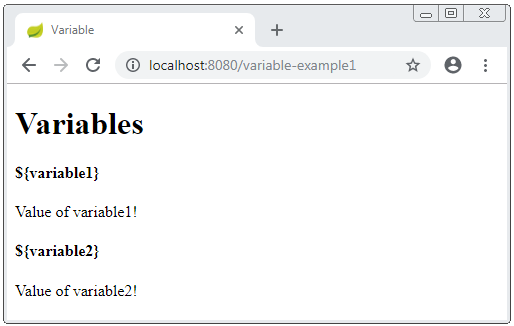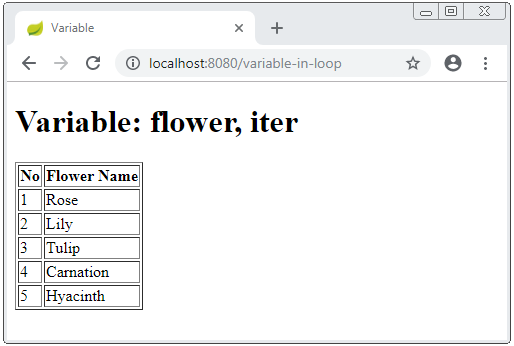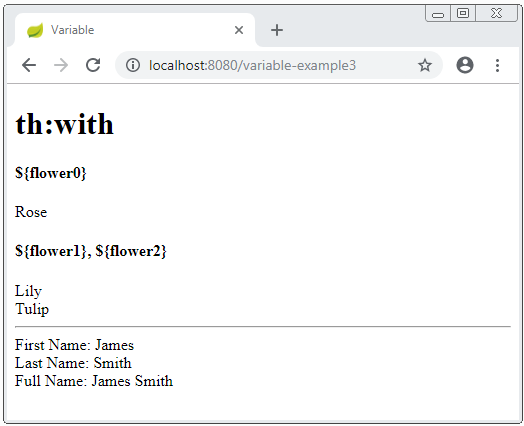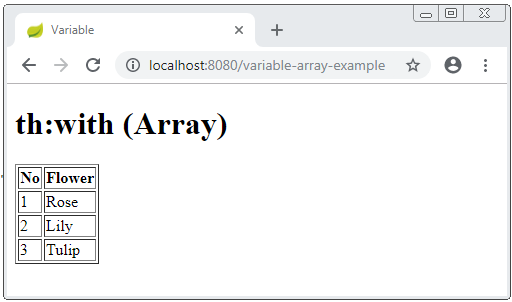Переменные (Variables) в Thymeleaf
1. Переменная (Variable)
Вы знакомы с понятием переменной (variable) в языке Java. Но как же в Thymeleaf? Конечно, Thymeleaf так же имеет понятие о переменной.
Атрибут (attribute) объекта org.springframework.ui.Model, или атрибут (attribute) объектаHttpServletRequest является переменной Thymeleaf. Данная переменная может быть использована везде в Template.
(Java Spring)
@RequestMapping("/variable-example1")
public String variableExample1(Model model, HttpServletRequest request) {
// variable1
model.addAttribute("variable1", "Value of variable1!");
// variable2
request.setAttribute("variable2", "Value of variable2!");
return "variable-example1";
}variable-example1.html
<!DOCTYPE HTML>
<html xmlns:th="http://www.thymeleaf.org">
<head>
<meta charset="UTF-8" />
<title>Variable</title>
</head>
<body>
<h1>Variables</h1>
<h4>${variable1}</h4>
<span th:utext="${variable1}"></span>
<h4>${variable2}</h4>
<span th:utext="${variable2}"></span>
</body>
</html>
Local Variables
Вы можете определить переменные в Template, они являются локальными (local) переменными, они существуют и используются только в разделе (section) у Template.
В данном примере, 2 переменных flower, iter существуют и используются внутри цикла, который объявил их.
(Java Spring)
@RequestMapping("/variable-in-loop")
public String objectServletContext(Model model, HttpServletRequest request) {
String[] flowers = new String[] {"Rose","Lily", "Tulip", "Carnation", "Hyacinth" };
model.addAttribute("flowers", flowers);
return "variable-in-loop";
}variable-in-loop.html
<!DOCTYPE HTML>
<html xmlns:th="http://www.thymeleaf.org">
<head>
<meta charset="UTF-8" />
<title>Variable</title>
</head>
<body>
<h1>Variable: flower, iter</h1>
<table border="1">
<tr>
<th>No</th>
<th>Flower Name</th>
</tr>
<!--
Local Variable: flower
Local Variable: iter (Iterator).
-->
<tr th:each="flower, iter : ${flowers}">
<td th:utext="${iter.count}">No</td>
<td th:utext="${flower}">Flower Name</td>
</tr>
</table>
</body>
</html>
th:with
Вы так же можете создать один или более локальных переменных через атрибут (attribute) th:with. Кго синтаксис похож на обычное выражение присваивания значения.
(Java Spring)
@RequestMapping("/variable-example3")
public String variableExample3(Model model) {
String[] flowers = new String[] {"Rose","Lily", "Tulip", "Carnation", "Hyacinth" };
model.addAttribute("flowers", flowers);
return "variable-example3";
}variable-example3.html
<!DOCTYPE HTML>
<html xmlns:th="http://www.thymeleaf.org">
<head>
<meta charset="UTF-8" />
<title>Variable</title>
</head>
<body>
<h1>th:with</h1>
<!-- Local variable: flower0 -->
<div th:with="flower0 = ${flowers[0]}">
<h4>${flower0}</h4>
<span th:utext="${flower0}"></span>
</div>
<!-- Local variable: flower1, flower2 -->
<div th:with="flower1 = ${flowers[1]}, flower2 = ${flowers[2]}">
<h4>${flower1}, ${flower2}</h4>
<span th:utext="${flower1}"></span>
<br/>
<span th:utext="${flower2}"></span>
</div>
<hr>
<!-- Local variable: firstName, lastName, fullName -->
<div th:with="firstName = 'James', lastName = 'Smith', fullName = ${firstName} +' ' + ${lastName}">
First Name: <span th:utext="${firstName}"></span>
<br>
Last Name: <span th:utext="${lastName}"></span>
<br>
Full Name: <span th:utext="${fullName}"></span>
</div>
</body>
</html>
Например, создайте массив (array) в Thymeleaf:
variable-array-example.html (Template)
<!DOCTYPE HTML>
<html xmlns:th="http://www.thymeleaf.org">
<head>
<meta charset="UTF-8" />
<title>Variable</title>
</head>
<body>
<h1>th:with (Array)</h1>
<!-- Create an Array: -->
<th:block th:with="flowers = ${ {'Rose', 'Lily', 'Tulip'} }">
<table border="1">
<tr>
<th>No</th>
<th>Flower</th>
</tr>
<tr th:each="flower, state : ${flowers}">
<td th:utext="${state.count}">No</td>
<td th:utext="${flower}">Flower</td>
</tr>
</table>
</th:block>
</body>
</html>
Pуководства Thymeleaf
- Оператор Elvis в Thymeleaf
- Цикл в Thymeleaf
- Условные операторы if, unless, switch в Thymeleaf
- Предопределенные объекты в Thymeleaf
- Использование Thymeleaf th:class, th:classappend, th:style, th:styleappend
- Введение в Thymeleaf
- Переменные (Variables) в Thymeleaf
- Использование Fragments в Thymeleaf
- Используйте Layout в Thymeleaf
- Использование Thymeleaf th:object и синтаксиса asterisk *{ }
- Пример Thymeleaf Form Select option
Show More